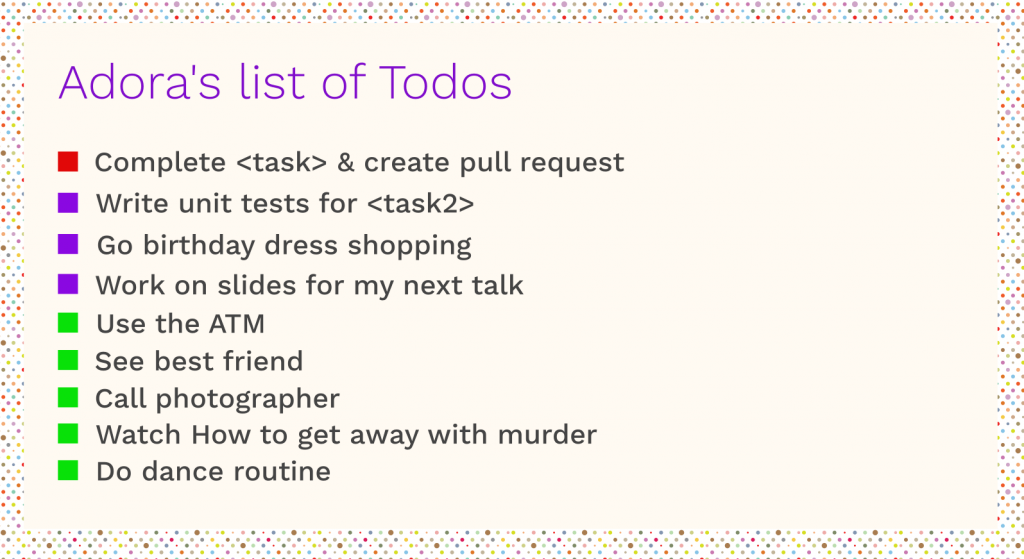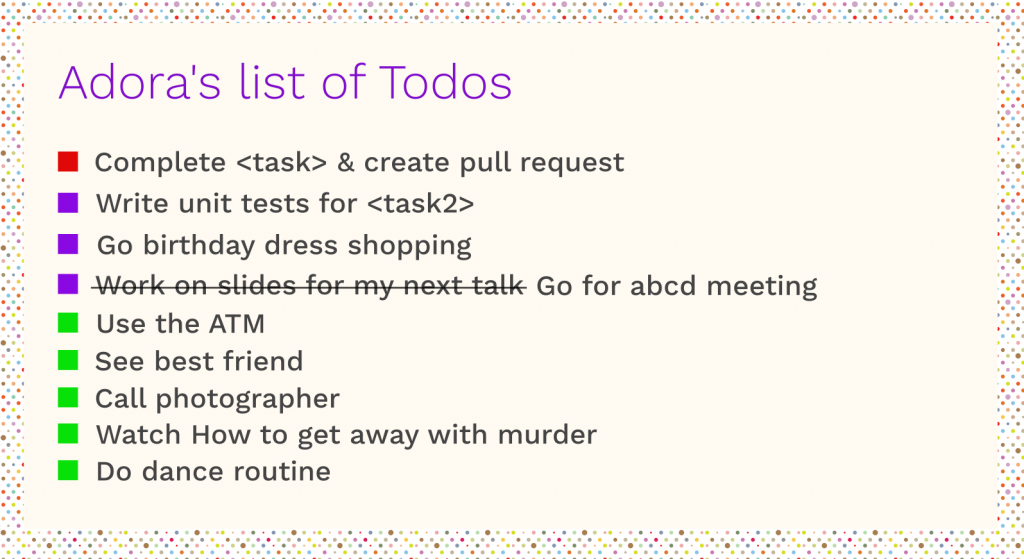An addiction to distraction will be the death of your creative production – Robin Sharma
It is important to note that you can always be busy and still be very unproductive so this is not about laziness and hard work. It’s about output from the work you do.
Last week, I had a lot of things to do aside from the tasks I do daily at my job or at home. This is because I’m a year older in a few days and trying to plan a birthday party when you have a 9/5 and live in a city where your commute is ~3 hours every day is an extreme sport and for some could be tagged impossible.
I was able to go through all my important tasks last week so I decided to share a few productivity methods I use in my life generally or in my work as a Software Engineer.
Some of these methods are:
- 1-3-5
- The 90/90/1 rule
- Attention management
1-3-5. What does that even mean?
The concept of the 1-3-5 is that you should spend your time during the day doing:
- One big and important thing
- Three medium and less crucial things
- Five small and not so important things
This basically means you need to learn to properly prioritize your todo list to these 9 things when planning your day.
Sometimes it might be difficult to finish all nine tasks on your todo list, but being realistic while also being optimistic, you’d have accomplished at least 3 – 4 of your top important tasks. This rule also makes it easy for you to rearrange things if an impromptu task comes up.
Cool. How do we do 1-3-5?
As opposed to drawing out a new todo list every day, you can create your tasks weekly (maybe the friday or sunday before the next week) but you’d still need to prioritize tasks each day. If an impromptu task comes up i.e. you were dragged into a last-minute meeting far away from work, you can always rearrange your list based on priority. I’d give an example below:

In the todo-list above, the tasks are prioritized by importance making the most important at the top of the list and the least important at the bottom.
How about impromptu tasks?
Using the image above as our todo-list example, if we get invited to an impromptu meeting, we could simply take out the least important purple task (a medium task) and push that to a later day. Our todo list will now look like this:

What happens to the task we just took out?
We would push that task to another day and reprioritize our tasks for that day to accommodate the new change.
The concept of 1-3-5 is in prioritizing our tasks. When it comes to execution, I use a framework called the 90/90/1.
90/90/1. Why are there so many numbers?
This concept of the 90/90/1 is that for the next 90 days, spend the first 90 minutes of your day doing the most important thing that could have so much impact on your life/business/job.
I find this very useful because there has been some research done on this subject and according to science, the best time of day to get work done is in the morning.
A short quote for this rule would be “Stop wasting your mornings, silly”.
Combining 90/90/1 with 1-3-5
A few years ago, I would spend my mornings watching the latest episode of my favorite TV show. It wasn’t like I was performing terribly, but I didn’t realize I was wasting my mornings and could achieve a lot more if I had done things better until I came across this and decided to try it out.
Basically, since we know that the 1-3-5 helps us prioritize our tasks and puts the single most important thing first, we can now decide to do the first task on the list in the morning. It’s important to note that it’s not just about doing tasks first, but also doing them at a time when we are at our best.
The task could be attending an important meeting, fixing an expensive bug in your app (trust me, you’d do a lot better when your head is clear), fixing up slides for your next talk or anything else. Whatever it is, do it in the morning.
Attention Management
Attention creates action, produces quality and helps facilitate productivity.
To be productive, we have to manage the sort of things we give our attention to so that we can concentrate and not lose focus. Attention management provides a way to stay focused. This is different from time management which basically helps us plan out and allocate times for our different tasks.
Simple ways to manage attention are:
- Put your devices away when you need to get tangible work done to reduce distractions in the form of social media or messaging apps
- Take a few breaks
- Sleep well
- Be disciplined about things you feel deserve your attention
- Be mentally alert to reduce the amount of time your mind wanders
- Fill up free spaces with things you love when you’re not resting to prevent unnecessary (and possibly negative) thoughts
Application to Software Developers
For some of us, we could be working on a coding task that is very important but we could still be blocked because we might need to carry out an entirely different task on our todo-list to complete a previous task.
Especially when you can’t explicitly say you’re done with a feature until you see that your pull request is merged. The rules stated in this article could also apply. Where those new tasks that spin out of already existing tasks are treated as impromptu tasks that we use to replace our medium and not entirely urgent tasks. I’d give an example below:
Scenario:
Imagine you have a todo-list with coding tasks taking up the top 4 slots in your list. If while working on task 2, you realize that you have to debug, investigate a new concept or create a pull request in a different repository because there’s a new feature you’d need that doesn’t currently exist (or even a bug in an open-source library you need to fix).
Solution:
You could take out a (medium) coding task and add this new task that is a dependency on your work, or you could group those two tasks together and make it a big task. This means it automatically becomes number one on your list. Once you’ve prioritized right, you can get to work and focus on your tasks to get them done.
Think about it like a priority queue that has just 9 slots. If the queue is full and you need to add to it, you’d need to dequeue elements with lower priorities.
It’s okay not to finish all your tasks in one day (except you’re like a 200x engineer) but the advantage this gives you is that you tend to be more productive overall because you’re checking important things off your list first as opposed to just anything.
Conclusion
To stay focused and get things done, I try to follow these principles as much as I can either at my home or at my job or in any other thing that I have to do.
I hope this article helped you learn new things about being productive. If you have other frameworks that help you stay productive or you want to take this conversation further, my DMs are open.

I love this, I think I’m going to try out the 1-3-5 next week and try to get used to it before I move to the 90/90/1
Thats nice! You totally should. I use them together and it helps a lot. I’m glad you love it 🙂
Never knew of the 1-3-5 concept, makes a lot of sense. Thanks for sharing. And, nice blog too 💛
Thank you 💛💛